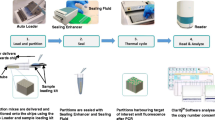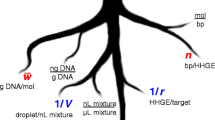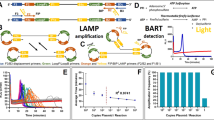Abstract
Polymerase chain reaction (PCR) end-point limiting dilution techniques, collectively termed “digital PCR (dPCR)”, have been proposed as providing a potentially primary method for DNA quantification. We are evaluating several commercially available dPCR systems for use in certifying mass concentration in human genomic DNA reference materials. To better understand observed anomalies among results from chamber- and droplet-dPCR (cdPCR and ddPCR) systems, we have developed a graphical tool for evaluating and documenting the performance of PCR assays in real-time cdPCR systems: the ogive plot, the cumulative distribution of crossing threshold values. The ogive structure appears to embed information about early amplification events. We have successfully simulated ogives observed with different assays and reaction conditions using a four-stage amplification model parameterized by the probability of creating an intact 1) first generation “long” amplicon of indeterminate length from an original DNA target, 2) second generation defined-length amplicon from a long amplicon, and 3) defined-length amplicon from another defined-length amplicon. We are using insights from this model to optimize dPCR assay design and reaction conditions and to help validate assays proposed for use in value-assigning DNA reference materials.

Cumulative distributions of crossing threshold (Ct) values for the same human genomic DNA evaluated with eight assays with a real-time chamber digital PCR platform. The shape and location of the curves (ogives) embed information about the PCR amplification process







Similar content being viewed by others
References
Kline MC, Duewer DL, Redman JW, Butler JM (2003) NIST mixed stain study #3: DNA quantitation accuracy and its influence on short tandem repeat multiplex signal intensity. Anal Chem 75(10):2463–2469
Sykes PJ, Neoh SH, Brisco MJ, Hughes E, Condon J, Morley AA (1992) Quantitation of targets for PCR by use of limiting dilution. Biotechniques 13(3):444–9
JCGM 200 (2012) International vocabulary of metrology –basic and general concepts and associated terms (VIM). Joint Committee for Guides in Metrology. Sèvres, France. http://www.bipm.org/en/publications/guides/vim.html
De Bièvre P, Dybkaer R, Fajgelj A, Hibbert DB (2011) Metrological traceability of measurement results in chemistry: concepts and implementation. Pure Appl Chem 83(10):1873–1935
Tellinghuisen J, Spiess A-N (2014) Comparing real-time quantitative polymerase chain reaction analysis methods for precision, linearity, and accuracy of estimating amplification efficiency. Anal Biochem 449:76–82
Tellinghuisen J, Spiess A-N (2014) Statistical uncertainty and its propagation in the analysis of quantitative polymerase chain reaction data: comparison of methods. Anal Biochem 464:94–102
Fuchs R, Blakesley R (1983) Guide to the use of type II restriction endonucleases. Methods Enzymol 100:3–38
CDC/NIH (2009) In: Chosewood LC, Wilson DE (eds) Biosafety in microbiological and biomedical laboratories, 5th edn. HHS publication No. (CDC) 21–1112. US Government Printing Office, Washington, DC. Available at http://www.cdc.gov/biosafety/publications/bmbl5/index.htm
Applied Biosystems (2003) Quantifiler human DNA quantitation kit and Quantifiler Y human male DNA quantitation kit user’s manual, Part Number 4344790 Rev A. Foster City
Stolovitzky G, Cecchi G (1996) Efficiency of DNA replication in the polymerase chain reaction. Proc Natl Acad Sci U S A 93:12947–12952
Acknowledgments
This work was supported in part by the National Institute of Justice through an interagency agreement with the NIST Special Programs Office.
Disclaimer
Certain commercial equipment, instruments, or materials are identified in this report to specify adequately experimental conditions or reported results. Such identification does not imply recommendation or endorsement by the National Institute of Standards and Technology, nor does it imply that the equipment, instruments, or materials identified are necessarily the best available for the purpose.
Author information
Authors and Affiliations
Corresponding author
Ethics declarations
Conflict of interest
The authors declare that they have no conflict of interest.
Electronic supplementary material
Below is the link to the electronic supplementary material.
ESM 1
(PDF 62 kb)
Rights and permissions
About this article
Cite this article
Duewer, D.L., Kline, M.C. & Romsos, E.L. Real-time cdPCR opens a window into events occurring in the first few PCR amplification cycles. Anal Bioanal Chem 407, 9061–9069 (2015). https://doi.org/10.1007/s00216-015-9073-8
Received:
Revised:
Accepted:
Published:
Issue Date:
DOI: https://doi.org/10.1007/s00216-015-9073-8




